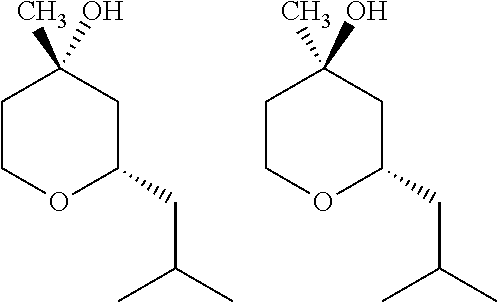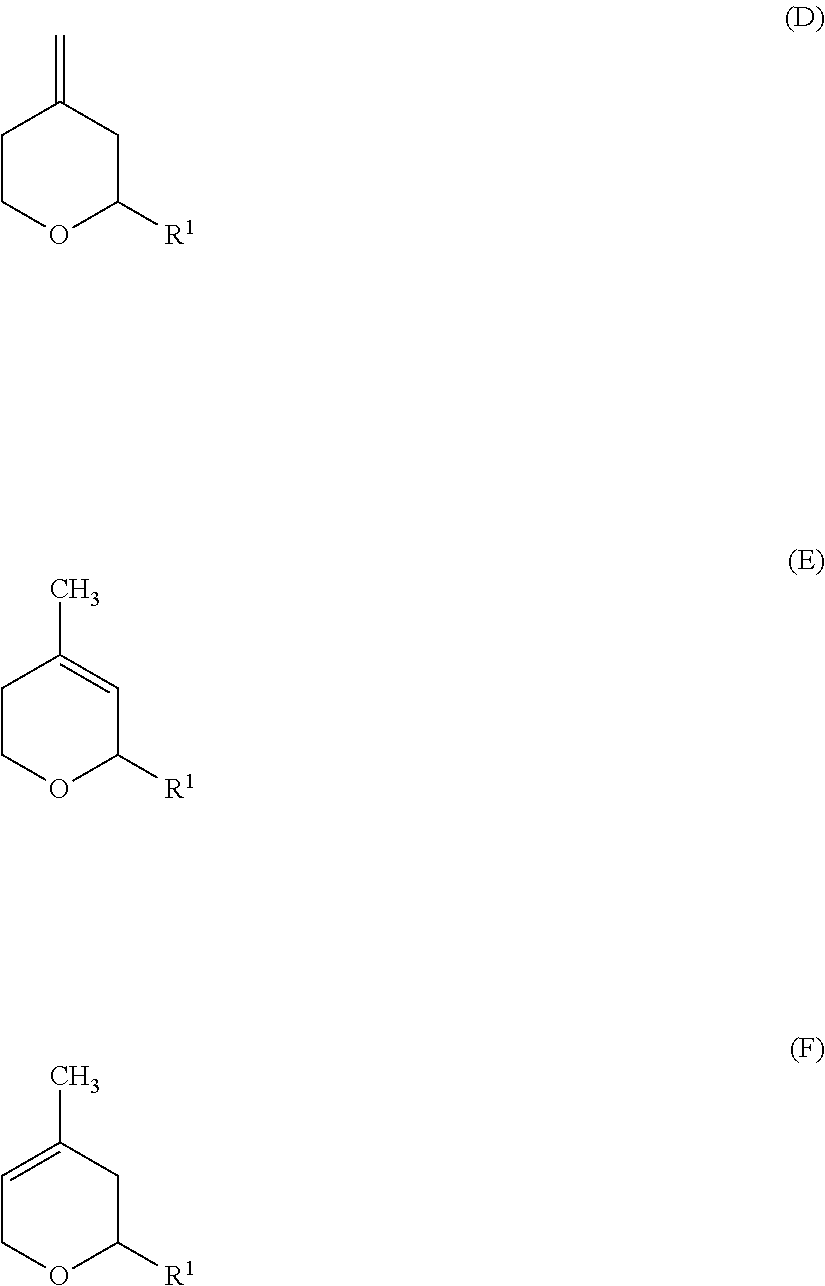Production of 2-substituted 4-hydroxy-4-methyltetrahydropyrans having stable odoriferous quality
a technology of methyltetrahydropyran and methyltetrahydropyran, which is applied in the production of fatty substances, essential oils/perfumes, organic chemistry, etc., can solve the problem that products often have undesired cheesy odor notes, and achieve the effect of avoiding the formation of troublesome odor notes
- Summary
- Abstract
- Description
- Claims
- Application Information
AI Technical Summary
Benefits of technology
Problems solved by technology
Method used
Image
Examples
example 1
According to the Invention
[0179]A mixture of isovaleraldehyde (112.5 g, 1.31 mol), isoprenol (125 g, 1.45 mol) and 12.5 g of water was reacted in the presence of 50 g of the strongly acidic cation exchanger Amberlyst® 131, as described in example 1 of WO2011 / 154330.
[0180]The resulting crude product had the following composition:
19.5 GC area % trans-pyranol (I)
56.1 GC area % cis-pyranol (I)
9.0 GC area % dihydropyran isomers 1-3
8.2 GC area % 1,3-dioxane
0.7 GC area % isovaleraldehyde
1.3 GC area % isoprenol
0.5 GC area % acetal
8.7% water (Karl-Fischer method)
[0181]The crude product was subjected to a distillative separation in an arrangement of a conventional distillation column and a dividing-wall column. The laboratory apparatus consisted of two laboratory columns. The separation efficiency of the first column corresponds to approximately 15 theoretical trays. For the separation of the two phases of the top condensate, a glass phase separator was incorporated. The lower aqueous phase w...
example 2
Comparison
[0194]The procedure was as in example 1 but no sulfuric acid was added to the crude product used for the distillation.
[0195]The pure product obtained at the side take-off of the dividing-wall column comprised:
25.5 GC area % trans-pyranol and
73.6 GC area % cis-pyranol
[0196]Olfactory evaluation of the pure product;
[0197]Smelling strip test 30 min: does not correspond to the specification
[0198]Gas space test: does not correspond to the specification
[0199]The distillation yield as regards cis- and trans-pyranol was about 98.0%.
PUM
| Property | Measurement | Unit |
|---|---|---|
| Percent by mass | aaaaa | aaaaa |
| Percent by mass | aaaaa | aaaaa |
| Percent by mass | aaaaa | aaaaa |
Abstract
Description
Claims
Application Information
 Login to View More
Login to View More - R&D
- Intellectual Property
- Life Sciences
- Materials
- Tech Scout
- Unparalleled Data Quality
- Higher Quality Content
- 60% Fewer Hallucinations
Browse by: Latest US Patents, China's latest patents, Technical Efficacy Thesaurus, Application Domain, Technology Topic, Popular Technical Reports.
© 2025 PatSnap. All rights reserved.Legal|Privacy policy|Modern Slavery Act Transparency Statement|Sitemap|About US| Contact US: help@patsnap.com



